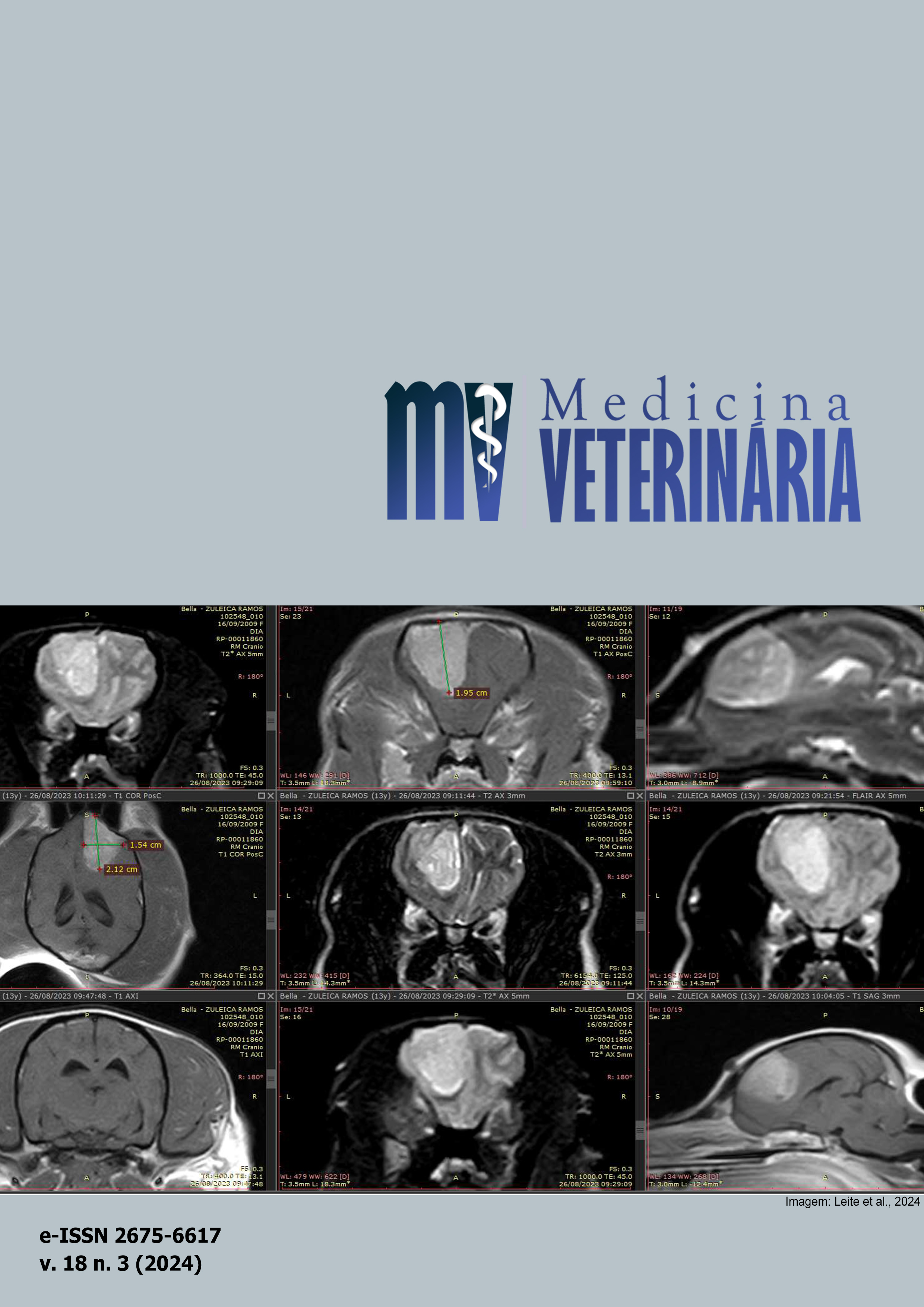Feline sporotrichosis: occurrence in the Metropolitan Region of the municipality of Recife and anatomical distribution of lesions on cats’ body
DOI:
https://doi.org/10.26605/medvet-v18n3-6284Palavras-chave:
Sporothrix, zoonosis, skin lesions, BraziResumo
Sporotrichosis is a fungal infection of worldwide importance caused by a saprophyte fungus of the genus Sporothrix. The objective of this study was to report the occurrence of feline sporotrichosis in the Metropolitan Region of the city of Recife and the anatomical distribution of lesions on the bodies of cats. Stray cats (n=100) with suggestive sporotrichosis lesions were examined. Material from the lesion was collected from all patients using an imprint and/or sterile swab for cytology. The material was placed on a glass slide and stained using rapid panoptic staining. Data on the localization of each skin lesion were recorded, and cigar-shaped yeast structures were searched at the microscopical examination. A heat map graphically represented the anatomical distribution of each lesion. In 70% (70/100) of samples were visualized fungal structure compatible with Sporothrix spp. There was a predominance of positive males (?2=6.691; p=0.0097). Skin lesions related to Sporothrix spp. infections were unevenly distributed throughout the animal's body. Based on the interpolation of data, the chance for detecting lesions was higher on the nose, anterior paw, and ears than on other body sites (H=40.0043; p=0.0000). Because of the high positivity in these cats, measures of health vigilance are imperative to reduce the risk of animal and human infection.Downloads
Referências
Barros, M.B.L.; Paes R.A.; Schubach A.O. Sporothrix schenckii and sporotrichosis. Clinical Microbiology Reviews, 24(4): 633-654, 2011.
Duangkaew, L. et al. Cutaneous sporotrichosis in a stray cat from Thailand. Medical Mycology, 21(s.n): 46-49, 2018.
Gremião, I.D.F. et al. Guideline for the management of feline sporotrichosis caused by Sporothrix brasiliensis and literature revision. Brazilian Journal of Microbiology, 52 (1): 107-124, 2021.
Han, H.S.; Kano, R. Feline sporotrichosis in Asia. Brazilian Journal of Microbiology, 52 (1): 125-134, 2021.
INMET - Instituto Nacional de Meteorologia. Normais climatológicas. Available at:<http://www.inmet.gov.br/portal/index.php?r=clima/normaisClimatologicas>. Accessed on: 6th February 2024.
Lacaz, C.S. Esporotricose e outras Micoses Gomosas. In: Lacaz, C.S. et al. Tratado de micologia médica, 9ª ed. Savier, São Paulo. 2002. p.479-487.
Larsson, C.E. Esporotricose. Brazilian Journal of Veterinary Research and Animal Science, 48(3): 250-259, 2011.
Oliveira Bento, A. et al. The spread of cat transmitted sporotrichosis due to Sporothrixbrasiliensis in Brazil towards the Northeast region. PLOS Neglected Tropical Diseases, 15(8): 1-20, 2021.
Marimon, R. et al. Sporothrix brasiliensis, S. globosa, and S. mexicana, three new Sporothrix species of clinical interest. Journal of Clinical Microbiology, 45(10): 3198-3206, 2007.
Miranda, L.H.M. et al. Co-infection with feline retrovirus is related to changes in immunological parameters of cats with sporotrichosis. PLoSOne, 13(11): 1-16, 2018.
PDUI –Plano de Desenvolvimento Integrado. A Região Metropolitana do Recife. Governo de Pernambuco, 2018. Available at: <https://www.pdui-rmr.pe.gov.br/RMR>. Accessed on: 15th May 2024.
Pereira, S.A. et al. Response to azolic antifungal agents for treating feline sporotrichosis. Veterinary Record, 166(10): 290-294, 2010.
Ramírez-Soto, M.C. et al. Ecological determinants of sporotrichosis etiological agents. Journal of Fungi, 4(3): 1-11, 2018.
Rediguieri, B.C. et al. Clinical, epidemiological, and epizootic features of Sporothrix brasiliensis in Espi?rito Santo, Brazil. EcoHealth, 19(1): 124-134, 2022.
Rodrigues, A.M. et al. The threat of emerging and re-emerging pathogenic Sporothrix species. Mycopathologia, 185(5): 813-842, 2020.
Ruyver, C., et al. Public opinions on seven different stray cat population management scenarios in Flanders, Belgium. Research in Veterinary Science, 136: 209-219, 2021.
Silva, G.M. et al. Surto de esporotricose felina na regia?o metropolitana do Recife. Pesquisa Veterinária Brasileira, 38(8): 1767-1771, 2018.
Silva, W. ONGs e poder público se unem contra o drama de abandono de animais. Folha de Pernambuco, 2019. Available at: https://www.folhape.com.br/noticias/ongs-e-poder-publico-se-unem-contra-o-drama-de-abandono-de-animais/116808/. Accessed on: 15th May 2024.
Waller, S.B. et al. Antifungal resistance on Sporothrix species: an overview. Brazilian Journal of Microbiology, 52(1): 73-80, 2021.
Downloads
Publicado
Como Citar
Edição
Seção
Licença
Copyright (c) 2024 Edson Moura da Silva, Luiz Felipe de Araújo França, Jéssica Cardoso Pessoa de Oliveira, Gílcia Aparecida de Carvalho, Daniel Dantas Moreira Gomes, José Wilton Pinheiro Júnior, Rafael Antonio Nascimento Ramos

Este trabalho está licenciado sob uma licença Creative Commons Attribution-NonCommercial-ShareAlike 4.0 International License.
- A Revista de Medicina Veterinária permite que o autor retenha os direitos de publicação sem restrições, utilizando para tal a licença Creative Commons CC BY-NC-SA 4.0.
- De acordo com os termos seguintes:
- Atribuição — Você deve dar o crédito apropriado, prover um link para a licença e indicar se mudanças foram feitas. Você deve fazê-lo em qualquer circunstância razoável, mas de nenhuma maneira que sugira que o licenciante apoia você ou o seu uso.
- NãoComercial — Você não pode usar o material para fins comerciais.
- CompartilhaIgual — Se você remixar, transformar, ou criar a partir do material, tem de distribuir as suas contribuições sob a mesma licença que o original.
- Sem restrições adicionais — Você não pode aplicar termos jurídicos ou medidas de caráter tecnológico que restrinjam legalmente outros de fazerem algo que a licença permita.










